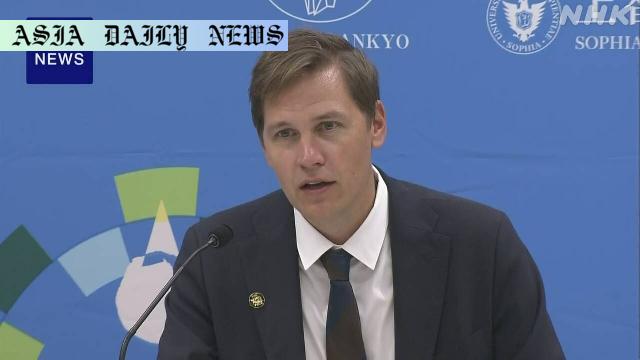Nuclear Disarmament: The Nobel Committee calls on young generations to preserve the legacy of atomic-bomb survivors.

The Legacy of Hibakusha and Their Call for Peace
The concept of “Hibakusha,” referring to survivors of the atomic bombings in Hiroshima and Nagasaki, carries a weighty responsibility: preserving an enduring legacy of peace. Recently, Joergen Frydnes, Chair of the Nobel Peace Prize committee, traveled to Japan to meet Nihon Hidankyo, the Japan Confederation of A- and H- Bomb Sufferers Organizations. This groundbreaking meeting was the first of its kind, signaling both a deep respect for the survivors as well as an urgent plea to ensure their stories resonate through future generations.
Frydnes emphasized the transformative power of the Hibakusha’s narrative, stating that their tragic experiences have led to a concerted effort to turn pain into constructive activism. The survivors, through relentless dedication and advocacy, have played a critical role in global anti-nuclear movements. As the world approaches the solemn 80th anniversary of the Hiroshima and Nagasaki bombings, this milestone serves as both a reflection of the past and a potential inflection point. It beckons a pivotal moment of reckoning for global nuclear disarmament policies.
The Role of Youth in Carrying the Torch
During his Tokyo speech, Frydnes made a direct, impassioned appeal to the younger generation, urging them to become stewards of memory and advocates against forgetting the atrocities of nuclear warfare. This powerful discourse came amidst global unease about a shifting and potentially unstable “new nuclear age.” Despite an alarming geopolitical climate, Frydnes firmly believes in the capacity for young advocates to effectuate change through steadfast commitment to raising awareness and initiating movements against nuclear armament.
Youth have always been at the vanguard of change, and Frydnes reminded them of their unique ability to leverage new tools, technologies, and platforms to transform conversation into policy impact. By taking up the torch of resistance against nuclear weapons, they honor Hibakusha’s legacy and amplify calls for lasting disarmament. Frydnes stressed with clarity and emotion the importance of maintaining the momentum of global social movements inspired by the courage of the survivors.
Civil Movements and Their Global Significance
The awarding of the Nobel Peace Prize to Nihon Hidankyo has reignited crucial dialogues around nuclear disarmament in civil societies worldwide. Beyond honoring their extensive efforts for peace, it underscores the dire need for collective action. Frydnes remarked on the resurgence of awareness, highlighting how social movements have been energized from disparate corners of the globe. This demonstrates the universality of the Hibakusha message, resonating across languages, borders, and cultures.
Activism illuminated by the Hibakusha’s experiences is critical now more than ever, as indications of escalating nuclear tensions serve as stark reminders of potential catastrophe. Whether through grassroots activism or policy-level advocacies, the involvement of civil societies creates a domino effect of consciousness, vital for propelling long-lasting global disarmament conversations. Nihon Hidankyo members have succeeded in crafting a narrative that transcends specific national cultures—a message of peace relevant to collective human experience.
The Importance of Storytelling: Preserving History for Future Generations
The preservation of witness testimonies is central to sustaining the moral and emotional weight of historical events. As Hibakusha grow older, it is imperative to institutionalize their stories through education, memorialization efforts, and intergenerational dialogues. Frydnes poignantly stated that young people must prioritize “resisting the forgetting” of these critical histories. Organizations like Nihon Hidankyo remain instrumental, not merely as advocates but as torchbearers enlightening future custodians of legacy.
By not letting silence grow, emerging generations can foster cultural and global understanding of the true implications of nuclear armament. With the advent of the 80th anniversary fast-approaching, ample opportunities exist to rewrite the narrative of nuclear weaponry into a collective one of disarmament, reform, and future-oriented peace initiatives. Collaborative storytelling that combines survivor accounts, new pedagogical tools, and digital engagement tools ensures that this pivotal lesson is never lost.
Commentary
The Transformative Legacy of the Hibakusha
The resonance of the Hibakusha legacy offers humanity an unparalleled opportunity to confront the repercussions of nuclear armament and warfare. The initiative taken by the Nobel Peace Prize committee, especially through the words of Joergen Frydnes, serves as a profound acknowledgment of the role memory and storytelling play in shaping a more harmonious world. The courage of the Hibakusha goes beyond their testimony—it’s their ability to transform tragedy into a powerful movement for peace that makes their efforts so impactful. It’s a legacy deserving of not just respect, but of amplification.
Why Youth Are at the Core of Global Change
Young people are uniquely positioned to catalyze transformational change. With the interconnectedness of today’s world, sparked by technological advancements and democratized access to information, they have tools at their disposal that were unavailable to previous generations. Frydnes’ call for youth advocacy resonates deeply because it acknowledges both the promise and responsibility of those who inherit historical truths. By becoming stewards of the Hibakusha legacy, young leaders can drive policy discourse, galvanize community action, and champion cross-cultural peace dialogues.
Nuclear Disarmament: A Collective Responsibility
As the planet navigates the complexities of an unstable nuclear age, the onus of change cannot rest solely upon governments or political institutions. Civil societies, learning communities, and individual storytellers hold the key to ensuring that the sacrifices made by the Hibakusha are not relegated to history books, but instead serve as living reminders of humanity’s resilience and responsibility to prevent future chaos. Movements inspired by testimonies like those of Nihon Hidankyo illustrate the extraordinary power of collective human will to confront existential crises.
The future depends on how we engage with the lessons of the past, and reinforcing the message of nuclear disarmament is a pressing call that can no longer be ignored. By embracing the youth’s potential and preserving the Hibakusha’s stories with reverence and urgency, we can take meaningful steps toward building a more peaceful, equitable world.


